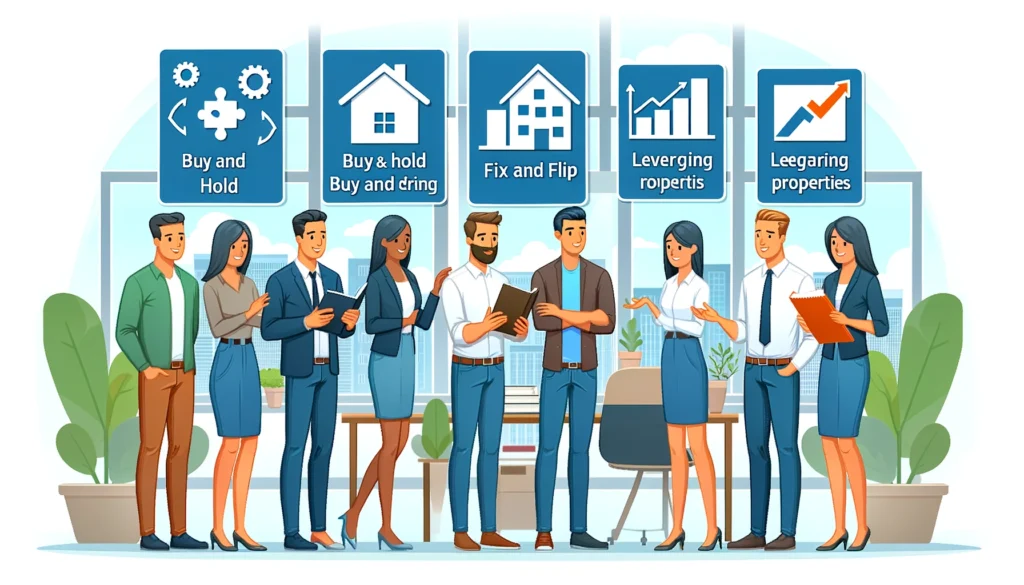ケーススタディ4: さまざまな不動産投資戦略の検討

ケーススタディ4: さまざまな不動産投資戦略の検討
ケーススタディの学習目標:
In this case study, students will follow David as he explores various real estate investment strategies, including buy and hold, fix and flip, and leveraging properties. This case study equips students with the knowledge to maximize returns through diverse investment strategies.
ケーススタディの概要:
ケーススタディ情報:
David is a 40-year-old real estate investor interested in exploring different investment strategies to maximize his returns. He plans to analyze the steps involved, benefits, and risks of each strategy.
仮説シナリオ:
David is evaluating different real estate investment strategies, including buy and hold, fix and flip, and leveraging properties. He needs to understand the steps involved, benefits, and risks associated with each strategy to choose the right approach based on market conditions and personal goals.
Part 1: Buy and Hold Strategy
パート1の情報:
The buy and hold strategy involves purchasing properties and holding them for an extended period to benefit from rental income and property appreciation.
- Steps Involved: Identify and purchase undervalued properties, manage rental properties, and hold for long-term appreciation.
- Benefits: Steady rental income, potential for significant property appreciation, and tax advantages.
- Risks: Market fluctuations, property management challenges, and potential for prolonged vacancies.
パート1の質問:
- What are the key steps involved in the buy and hold strategy for real estate investing?
- How can David mitigate the risks associated with the buy and hold strategy?
Part 2: Fix and Flip Strategy
パート2の情報:
The fix and flip strategy involves purchasing properties, renovating them, and selling them for a profit within a short period.
- Steps Involved: Identify distressed properties, renovate to increase value, and sell quickly for a profit.
- Benefits: Potential for high returns in a short period, opportunity to add significant value through renovations.
- Risks: High upfront costs, potential for renovation delays, and market volatility affecting sale prices.
パート2の質問:
- What are the key steps involved in the fix and flip strategy for real estate investing?
- How can David manage the risks associated with the fix and flip strategy?
Part 3: Leveraging Properties
パート3の情報:
Leveraging properties involves using borrowed capital to increase the potential return on investment.
実際の例:
Leveraging Properties:
- David purchases a rental property worth $300,000 with a $60,000 down payment and finances the remaining $240,000 with a mortgage.
- Rental Income: The property generates $2,500 per month in rental income.
- Mortgage Payments: Monthly mortgage payments total $1,200, leaving a net rental income of $1,300.
- Appreciation: Over five years, the property’s value appreciates to $400,000, providing significant equity gains.
パート3の質問:
- How can leveraging properties enhance David’s return on investment?
- What risks should David consider when using leverage for real estate investments?
重要なポイント:
- バイアンドホールド: Provides steady rental income, long-term appreciation, and tax benefits.
- 修正して反転する: Offers potential for high short-term returns through renovations and quick sales.
- Leveraging Properties: Increases purchasing power and potential returns but comes with higher financial risk.
ヒント、アドバイス、ベストプラクティス:
- 徹底的に調査する: Understand the steps, benefits, and risks associated with each investment strategy.
- Diversify Investments: Spread investments across different strategies and property types to manage risk.
- Manage Finances: Create detailed budgets, secure reliable financing, and maintain cash flow management.
- Consult Professionals: Seek advice from real estate professionals to develop and execute investment strategies effectively.
閉会の辞:
Congratulations on completing this case study! By exploring different real estate investment strategies and applying practical examples, you have gained valuable insights into maximizing returns through diverse approaches. Keep researching, stay informed, and use various strategies to achieve your real estate investment goals. Happy investing!

